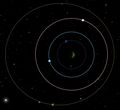Jool
Jool is a gas giant and the sixth planet of the Kerbol star system. It is the Jupiter analog for Kerbal Space Program. Aside from Kerbol, Jool has the largest diameter and greatest mass of all celestial bodies. While its distance from Kerbin makes it difficult to reach, it is one of the most appealing targets for missions due to its large and complex system of five moons: Laythe, Vall, Tylo, Bop, and Pol.
Atmosphere
|
Although Jool has a radius ten times greater than Kerbin, its atmosphere begins just twice as high (138.2 km). It is extremely dense, well suited for aerobraking from a high-speed interplanetary intercept. Orbiting just outside the atmosphere will give you a period of 94.7437 minutes, and a speed of 6,785 m/s. You typically do not need to go lower than 100 km to aerobrake. In general, the atmospheric pressure on Jool at an altitude expressed in meters is: Closer to the surface, the physics of the game start to break down. Due to its extremely thick atmosphere, terminal velocity is so low that lighter spacecraft will not even need parachutes or retrorockets. It is not impossible to land on its solid surface, though spacecraft are inevitably and invariably devoured by the Kraken. If the craft is very small, it may survive the Kraken, but the parts will explode once they are 100m below the surface. The message "... collided with Cloud" will display in the mission summary. If a Kerbonaut is put on EVA he will not be destroyed, making one-way sacrificial landings possible. However, as seen near the end of this video, the Kerbonaut will start to glitch out and shake uncontrollably. This only happens if you're on time warp 4. The game will later glitch and cut to a black screen with the altimeter going through numbers rapidly. Unless you restart the game, Kerbin's atmosphere will be missing. |
Natural Satellites
 The ocean moon Laythe, about to transit Jool. Jool has five natural satellites, each with an orbit well-aligned with Jool's orbital plane:
Laythe, Vall, and Tylo are in a Laplace resonance, with orbital periods of 1:2:4 respectively. Despite the fact that the moons can easily eclipse both each other and Jool, they do not. Synchronous Orbits around any of the Joolian moons are not possible, as they all would lie outside the SoI of the orbit's parent body. |
Gallery
- Screenshot540.png
Low orbit over Jool.
- Screenshot73.png
A Probe that has winglets to steer. Note that as you descend deeper into the atmosphere, it gets harder to move at all, rendering RCS and winglets useless.
- Screenshote4141412.png
A view of Laythe, Vall and Tylo during an aerobraking on Jool.
Trivia
- Jool has roughly the same equatorial radius as the planets Earth and Venus.
- The sunsets and sunrises on Jool are a shade of yellowish brown.
- Like Jool, Jupiter's nearest three moons (Io, Europa, and Ganymede) have a Laplace resonance of 1:2:4.
Changes
- Added a new, more distant moon named Pol.
- Initial Release






